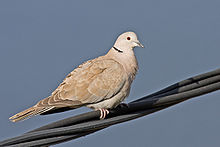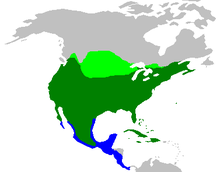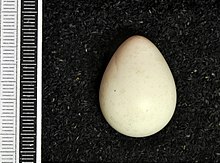Caroline pigeon
| Caroline pigeon | ||||||||||
|---|---|---|---|---|---|---|---|---|---|---|

Carolina pigeon ( Zenaida macroura ) |
||||||||||
| Systematics | ||||||||||
|
||||||||||
| Scientific name | ||||||||||
| Zenaida macroura | ||||||||||
| ( Linnaeus , 1758) |
The mourning dove ( Zenaida macroura ), also mourning dove called, is a medium-sized bird in the family of pigeons (Columbidae). It inhabits North and Central America in several subspecies. As with all weeping pigeons , their plumage is inconspicuous and has several shades of brown. They are characterized by the black spot on the cheeks, the dark spots on the wings and black and white markings.
The Carolina pigeon is one of the most common birds in North America and is heavily hunted. More than 70 million of these species are shot annually in the United States . The reproduction rate of the Carolina pigeon is very high. In climatically favorable regions, a pair of Carolinian pigeons can raise up to six clutches. Two to three annual broods are also typical in less favorable regions.
Appearance
Carolina pigeons reach a body length of 30 centimeters and weigh an average of 110 grams. A noticeable gender dimorphism is not present.
Carolina pigeons have a relatively small head with a small, pointed beak. There are black spots on the wing covers. The upper side plumage has a grayish brown color, the lower side plumage and the head area a light pink color. Overall, the plumage color in the male is lighter. Below the ear there is a black spot on either side of the head. They have long, graduated tail feathers. They have a light blue ring around their eyes.
Similar species
There are several species of pigeon that have plumage similar to the Carolinian pigeon. The turkish dove , which was introduced in the United States , does not have a wedge-shaped elongated tail, unlike the Carolina dove . It also lacks the black spots on the sides of the head and the drawing on the wings. In contrast to the Carolinian pigeon, the Turkish pigeon is more powerfully built and lighter on the underside. The most striking distinguishing feature between these two species, however, is the dark neck band of the turkish dove.
The distribution area of the coastal pigeon, which is also very similar, overlaps with that of the Carolina pigeon in the Bahamas, Jamaica, Hispaniola and Puerto Rico. The coastal pigeon is overall much darker than the Carolina pigeon. In particular, the almost red-brown top of the body of the coastal pigeon makes it easy to differentiate between the two species.
distribution
The range of the Carolinian pigeon extends over almost eleven million square kilometers. Carolina pigeons are found in the Greater Antilles , most of Mexico, the United States and southern Canada. In Canada as well as in the northern United States, the Carolina pigeon is a migratory bird. In the south of Central America, the Carolinian pigeon is not a breeding bird, but only winters here.
The Carolinian pigeon is often seen as a stray visitor in northern Canada, Alaska and South America. In the western Palearctic she has appeared several times as an errant. In total, she was observed five times in the British Isles and once each in the Azores and Iceland.
The Carolina pigeon was introduced to Hawaii in 1963. A small breeding population existed on North Kona at least until 1998 . The Carolinian pigeon has now also colonized the island of Socorro on the west coast of Mexico. The colonization took place 16 years after the Socorrotaube was exterminated there.
behavior
It is incubated five to six times a year on trees, bushes or buildings. While the nest is being built, the female stays with the nest that is open at the top and receives the nesting material that the male collects. The female lays two white eggs in the nest. Both adult birds participate in the breeding business. Usually the male incubates from early morning until late noon, the female the rest of the day and night.
They feed mainly on grains and seeds such as wheat , maize , millet , rye , barley , oats and buckwheat , and also, although less often, on fruits and insects . To aid digestion, they pick up fine gravel and swallow it.
Carolina pigeons are widespread birds in the south of Canada through North America to Panama . They inhabit meadows, farmland, forest edges and areas in cities, often near water points, streams or rivers. They are heavily hunted during their migration. However, their populations are still largely stable.
Keeping in human care
The Carolinian pigeon does not play a very important role in European wild pigeon keeping, although it is often referred to as an easy-to-keep pigeon. In the United States, Carolina pigeons are widely used as nurse birds. Albinos have also been bred in the attitude there.
supporting documents
Individual evidence
- ↑ Rösler, p. 184
- ↑ Rösler, p. 184
- ↑ Birdlife International : Mourning Dove - BirdLife Species Factsheet . Retrieved October 8, 2006.
- ↑ Mourning Dove ( Zenaida macroura ) (PDF; 872 kB) In: Fish and Wildlife Habitat Management leaflet 31 . National Resources Conservation Services (NRCS). February 2006. Archived from the original on September 23, 2006. Info: The archive link was automatically inserted and has not yet been checked. Please check the original and archive link according to the instructions and then remove this notice. Retrieved October 8, 2006.
- ^ Kenn Kaufman: Lives of North American Birds . Houghton Mifflin, 1996, ISBN 0-395-77017-3 , p. 293.
- ^ South American Classification Committee American Ornithologists' Union: Part 3. Columbiformes to Caprimulgiformes . In: A classification of the bird species of South America . Archived from the original on January 9, 2010. Info: The archive link was automatically inserted and not yet checked. Please check the original and archive link according to the instructions and then remove this notice. Retrieved October 11, 2006.
- ↑ Jonathan Alderfer (Ed.): National Geographic Complete Birds of North America , ISBN 0-7922-4175-4 , p. 303.
- ↑ Check-list of North American Birds (PDF; 7.8 MB) American Ornithologists' Union . P. 224. 1998. Retrieved June 29, 2007.
- ↑ Check-list of North American Birds (PDF; 7.8 MB) American Ornithologists' Union . P. 225. 1998. Retrieved June 29, 2007.
- ↑ Münst, p. 79
literature
- David Gibbs, Eustace Barnes and John Cox: Pigeons and Doves - A Guide to the Pigeons and Doves of the World . Pica Press, Sussex 2001, ISBN 90-74345-26-3 .
- Alois Münst and Josef Wolters: Pigeons - The types of wild pigeons . 2nd expanded and revised edition, Verlag Karin Wolters, Bottrop 1999, ISBN 3-9801504-9-6 .
- Gerhard Rösler: The wild pigeons of the earth - free living, keeping and breeding . M. & H. Schaper Verlag, Alfeld-Hannover 1996, ISBN 3-7944-0184-0 .
Web links
- Zenaida macroura in the endangered Red List species the IUCN 2008. Posted by: BirdLife International, 2008. Accessed on December 21 of 2008.
- Videos, photos and sound recordings of Zenaida macroura in the Internet Bird Collection
- Carolinian pigeon feathers



